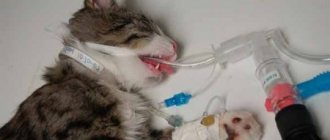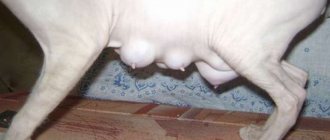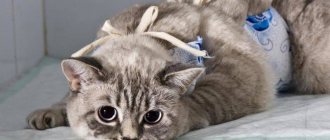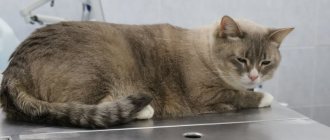12819Administration
Many owners of furry beauties choose to sterilize cats, since the operation is quite simple and with proper care for the animal, the healing process proceeds safely, without causing serious consequences.
An important role is played by a blanket that covers the cat's seam, protecting against the entry of germs and licking of the wound. It is necessary to know when to remove the blanket from a cat after sterilization, and try not to violate the deadlines, since the further well-being of the pet directly depends on this.
Why is it needed?
A blanket is required for an animal undergoing abdominal surgery. It performs several functions:
- covers the postoperative suture;
- prevents contamination and infection;
- protects against scratching and licking of the wound surface.
When the stitches are treated, the dressing or bandages are changed, it is not always necessary to remove the bandage. If the postoperative suture is located at the bottom, it is enough to untie several ties and bend the edges to gain access to the desired area.
If the bandage becomes contaminated with discharge from the wound, it will have to be replaced to prevent infection from entering the seam and the development of inflammation.
Often, immediately after surgery, a blanket is placed on the cat. However, with intradermal sutures there is no need to protect the surgical field. But such sutures are rarely used during sterilization.
What types of blankets are there for cats?
There are several types of protective clothing for pets. The products differ from each other in material and cut features. Each option has its own purpose.
Warm
During the cold season, hairless cat breeds get cold and run the risk of catching a cold. Caring owners of Sphynxes and Cornish Rex dogs dress their pets in warm sleeveless vests. Soft fabric with a small pile perfectly protects from the wind and warms the animal during a walk. Even better are knitted wool blankets that fit the body. This product replaces the mustachioed friend’s own fur.
For hairless cat breeds, a warm blanket is an indispensable wardrobe item.
Homemade
Among furry pets, there are also those who suffer from allergic shedding. The owners have to constantly vacuum the furniture and often comb out the animals, although this does not save the situation. But you shouldn’t envy owners of “hairless” cats. Unfortunately, they have another physiological feature - increased sweating. There are stains on sofas and armchairs that are difficult to remove. Therefore, pets are dressed in blankets made of light cotton fabric, reminiscent of a robe or T-shirt. Such clothing absorbs skin secretions well and limits hair loss.
A satin blanket will protect furniture from your pet's sweating
Most home capes still belong to wardrobe items. However, some models are necessary for the daily care of animals with incurable diseases.
When veterinarians discovered a tumor on an elderly cat's mammary gland, the owners were forced to make difficult choices. They did not agree to the operation, which still would not bring recovery. The pet constantly reached out to the sore spot and licked it. Redness and inflammation began. Then the owners put a loose blanket on the cat. It is surprising that the animal quickly got used to the “cover” and only slightly protested at first. The tumor, covered with tissue, became less inflamed by the actions of the furry pet. The use of a protective device thus made it possible to extend the earthly existence of a doomed living creature for another year and a half.
Fastening a blanket with a zipper is much more convenient than tying ribbons
Raincoats
When walking with your pet outside in cloudy weather, do not forget to take a rain cape for your pet. The model has a hood and fastens under the neck and belly. The product is sewn from waterproof material - nylon or vinyl chloride. Polyamide fiber of bright color is not inferior in properties to transparent film. In the event of an unexpected downpour, only the animal's paws will get wet in such a raincoat.
Postoperative blankets
It's hard to say when veterinarians came up with the idea of covering surgical stitches on pets with a large bandage that attaches to the back. Since the sixties of the last century, only an Elizabethan collar was used to isolate the wound from the animal’s reach. The cone attached to the cat's neck caused significant inconvenience. Not only could the pupil not wash her face, she found it difficult to drink and eat. The owner watched with pity as the funnel knocked on the cup of food, but the food did not fall into the mouth. We had to temporarily remove the device and risk the health of our mustachioed pet. Moving around the rooms threatened with injury: the edges of the cone clung to furniture and door frames.
It is not surprising that the blanket has become an excellent replacement for a neck device after abdominal surgery. It's nice to see that your pet feels freer and can even play. Although the protective mantle with ribbons still restricts movement, it does not prevent the cat from eating and caring for itself normally. Therefore, the animal’s recovery occurs faster.
And now in some European countries veterinarians only use a collar. As an alternative, they recommend that owners put homemade sleeveless vests on their animals, made from baby overalls for infants.
What to do if the cat takes off the blanket on its own
The animal will not be able to remove the bandage that is properly secured. A cat that has been castrated along the linea alba should be in a blanket until the postoperative wound heals.
If your cat removes the bandage, you must carefully read the instructions to secure it correctly and prevent it from being removed in the future.
When treating a seam using a special spray, you do not need to use a blanket (in this case, the wound is reliably protected from contamination and infection).
Postoperative care in the first days
During the first days after sterilization, it is imperative to monitor the condition of the blanket, which must remain clean and protect the postoperative suture from contact with the external environment. The nature of the diet should be such that constipation does not occur. In the future, the sterilized cat is fed smaller portions to prevent obesity. The volume of her diet will need to be reduced by 20-25%. During rehabilitation it is prohibited:
- allow the cat to lie down on a warm radiator;
- smear the seam with an antiseptic containing alcohol;
- overfeed the animal, leaving food for the whole day;
- remove the blanket until the seam heals;
- allow active games with jumping;
- pick up the cat, supporting it only with its front paws.
Why you shouldn’t scold a cat: what can offend your pet
give your animal water without restrictions . If before this the pet was fed dry food, now it is worth choosing a special line of product for sterilized cats. Walks are acceptable, but they must be short and supervised.
The animal should be picked up by picking it up under all four paws, without putting pressure on the stomach.
How to remove a blanket correctly and when to do it
How long a cat can wear a bandage after sterilization depends on the method of surgery, the state of health, and the behavior of the animal.
In most cases, it can be removed after 1-1.5 weeks (depending on the decision of the veterinarian). If threads were used during the operation, sutures will need to be removed. After their removal, you can stop wearing the bandage any further. If the cat's sutures are removed, it means the healing process has been successful.
It is necessary to extend wearing the bandage for 2 or 3 days if:
- the animal is active, runs and jumps a lot;
- the cat licks the incision area;
- After examining the animal, the doctor decided to postpone removing the stitches for a while.
After 5-7 days, you can remove the bandage if self-absorbable suture material was used during the operation.
Extending the life of the blanket may be necessary as a result of:
- poor scarring;
- impaired coordination in the animal during the period after surgery;
- vigorous licking of the incision site.
Using a blanket
The blanket is a postoperative bandage that protects the suture on the abdomen from dust and germs. The device is fixed on the cat immediately after the operation in a veterinary clinic, and in the first days the owner only has to make sure that the blanket does not move out. The bandage is designed in such a way that the animal can move and go to the toilet without hindrance.
Scientists have discovered why cats hate dogs: the origins of mutual enmity
It is worth saying that not all pets calmly perceive a foreign object on themselves. On forums, pet owners are often interested in what to do if their cat takes off its blanket. The owner will have to observe the behavior of the animal and stop such attempts.
If the blanket gets dirty, it is recommended to wash it, dry it quickly and put it on again, making sure that the cat does not lick the seam during this period. The surface of a cat's tongue is like sandpaper, and the disturbed wound can begin to fester, which already threatens complications including peritonitis.
Early withdrawal
How many days after sterilization a cat will need to use a bandage depends on many conditions. You can reduce the duration of use of the blanket if:
- the pet becomes aggressive and tries in every possible way to get rid of the blanket;
- the cat behaves passively, lies most of the time, refuses food and water, is afraid to walk;
- the pet does not rise from its bed, signs of deterioration in health appear: the nose becomes hot, weakness and lethargy appear;
- abrasions are noticeable in places of contact with the bandage;
- the blanket appears dirty or torn.
Postoperative blanket: what is it and what is it for?
A blanket is a tight “cover” placed over the stomach of an operated cat.
It serves several purposes at once:
Protects the postoperative wound from contamination by pathogenic and conditionally pathogenic microflora.
The blanket prevents the animal from trying to scratch and lick its belly. This is a reflexive behavior of a cat trying to speed up the healing process. But in practice, constant licking of the wound leads to the exact opposite result.
Also, a pressure bandage pulls the edges of the wound together, which promotes healing by primary intention. Simply put, regeneration in this place will go faster, and not so many reserves of the animal’s body will be spent on it.
A properly applied and high-quality blanket does not allow the muscular wall of the abdominal wall to stretch too much and weaken. This prevents the belly from sagging in the future.
How to properly put a blanket on a cat
It is better to tie a blanket while the animal is still under anesthesia. Adjust the length of the ties so that the loose ends do not interfere with the animal. It is better to immediately cut off the excess so that the cat cannot accidentally get caught on something and injure itself during the owner’s absence.
Observe how the cat behaves. If wearing a blanket for the first time causes stress, remove the product from it and try putting it on again after a while. Don't expect a pet in a bandage to behave the same way as usual, because these freedom-loving animals do not like to have something put on them.
Making a DIY bandage for cats is not that difficult. But you need to follow all the rules of work and wear it correctly.
The subsequent effectiveness for your cat depends on the cut of the blanket. It also needs to be tied correctly. If the ties are too tight, then the stitches and wounds after sterilization in cats will take a long time and heal poorly. And if they are too loose, the seams will rub when moving, or the cat will try to take it off.
You need to put a blanket on a cat like this:
- lay out the product and straighten the ties on it;
- carefully place the cat on top and secure the ties in front in the area of the head and forelimbs;
- We tie the back ties in pairs and tie them in the cat’s pelvic area.
The sequence of actions may differ slightly from the one given, it all depends on the cut of the bandage. Be sure to ensure that the blanket is properly secured. Let the cat walk around the room, if it is calm and does not try to remove it, then everything has been done correctly.
Most often, animals do not really like such clothing. They constantly chew and tear the bandage, trying to get rid of it. That is why you need to carefully select the fabric if you sew it yourself, so that it is durable and pleasant to the touch.
In order for the blanket to perform its function, it must be worn correctly. When putting on a bandage, it is forbidden to tighten it too much with ties. It is also prohibited to let it dangle from the pet. The product should not hinder the movement of the animal. The blanket is worn with a tight fit to the body.
A homemade bandage, if made correctly, will allow your pet to endure the postoperative recovery period well and return to a full life.
If the animal is under anesthesia, then putting a bandage on it will be quite simple. Another situation is when the cat resists. Then doing it alone is not recommended. It's better to ask someone at home to help.
Caution: Do not squeeze the cat too hard, as this may cause the seam to come apart. If you need to put a blanket on a cat that has already recovered from anesthesia, act not with coercion, but with affection
Those who are going to put a bandage on a pet for the first time and feel unsure should practice on inanimate objects, for example, toys, and only then approach the cat.
Sometimes the cat strongly resists and does not allow the blanket to be put on itself. After some time, you can repeat the attempts, because over time the animal gets used to this procedure. As well as, for example, rubbing the eyes.
Step-by-step instruction:
- First you need to tie the laces closest to your neck. Grab your head, but gently.
- Now tie the ones between the neck and front legs.
- Tie each pair of laces towards the tail.
- The last two ribbons must be tied crosswise around the cat's rump.
And do not forget to leave the anus and urethra open. Otherwise, the pet will not be able to go to the toilet normally and will worry or stain the bandage. Make sure that the blanket not only does not cover, but is not too close to the urethra and does not become wet from the animal’s urine.
Sometimes it happens that a cat, after putting a bandage on it, cannot move calmly. Then it is worth loosening the tapes so that the animal does not suffer, because he already needs to recover from the operation.
You should put on the blanket as carefully as possible: after the operation, when the stitches are healing, any careless movement can cause pain to your pet. Tying a post-operative blanket is an art
But after studying the diagram below, you can easily figure out what’s what.
Blanket fastening diagram
We tie the sixth and seventh pair on the outside of the thighs. Already tied, we connect the ends of ties 6 and 7 above the base of the tail.
DIY bandage
So the cat had surgery. A cat blanket can be used after DIY sterilization to protect the seam. Sewing blankets is a fairly simple matter, but you should approach it responsibly. For sewing you will need thick, preferably cotton, fabric. A simple DIY cat blanket consists of a bandage and ties. The fabric is put on the stomach, the first line of ties is attached to the animal’s neck, the second under the front legs, the third in the abdomen, the fourth in front of the hind legs, the fifth under the hind legs, the sixth secures the bandage at the tail. Roughly speaking, it is a rectangle of fabric with notches for paws and ties.
A simple bandage for a cat after sterilization can be made with your own hands from scrap materials. Often thick tights, leggings, sleeves from turtlenecks and other suitable things are used for this. You should cut off a piece of trouser leg or sleeve in accordance with the length of the cat’s body, then make holes for the front legs, put it on the cat and fix it loosely with a knot on the neck.
If the seam is low and the bandage rides up, you can also make slits for the hind legs. Such overalls are much more elastic than a cotton blanket, restrict the animal’s movements less, cause much less discomfort, and are easier to put on and take off if necessary. When wondering how to make a blanket for a cat, you can consider both options, which one your pet will accept better.
Behavioral changes after sterilization
A month or more after sterilization, it is difficult to guess that the cat has undergone surgery. The pet returns to its usual lifestyle, eats well and plays actively.
Against the background of recovery after sterilization, the cat’s body balances its hormonal levels, which may be accompanied by some behavioral changes.
Contrary to popular myths, a sterilized cat does not become apathetic, resentful, misses sex life, etc. Most often, sterilized cats become more affectionate towards their owner, spend more time playing, and become much more active at night.
However, some owners encounter real problems and notice that the cat has become aggressive or has begun to ignore the litter box.
treatment of sutures after surgery in cats
Processing and removal of seams
A surgical suture is a connection between the edges of organ tissue after surgery or injury; it is made to prevent infection or foreign bodies from entering an open wound and speed up its healing.
After suturing, pets require special care. If for some reason you cannot care for the suture yourself, then you should seek the help of a veterinary clinic. The doctor will examine the postoperative wound and treat the suture. 4-5 days after suturing, a painless compaction may appear - granulation, which will soon resolve. As a rule, 10-14 days are enough for the wound to heal and the skin to grow together.
Treatment of seams after sterilization
As for the sutures, they can fester or become wet after surgery, and this can also lead to a number of complications. ... Sterilization of cats: when to start? The appropriate time to sterilize a cat varies in each situation.
After the sutures are removed, no restrictions on movement or feeding are required. ... After sterilization, your animal will not exhibit sexual behavior, will become calmer, less aggressive, and the cat’s estrus will naturally stop.
harmless sterilization (castration) to abdominal surgery necessary to save the life of the animal. ... Purchase dressing material (sterile wipes), an antiseptic and a preparation for lubricating the sutures after treatment in advance. Treat wounds
The optimal age for sterilizing a cat is 7-8 months. At this age, the animal will tolerate anesthesia well. ... After the sutures are removed, no restrictions on movement or feeding are required. The operation is simple, very easily tolerated by cats and there are no complications.
Materials for sutures are especially carefully sterilized, since the most minor omissions in the sterilization process can lead to... Therefore, the surgeon
Source











